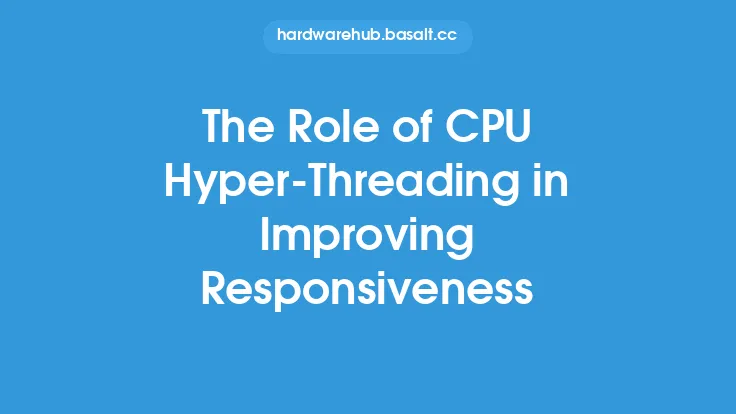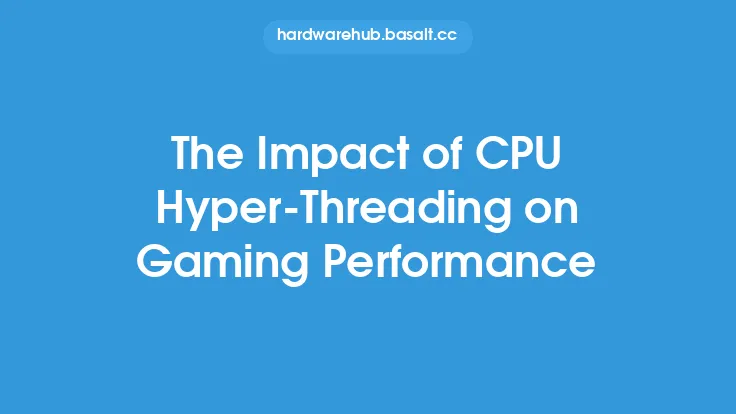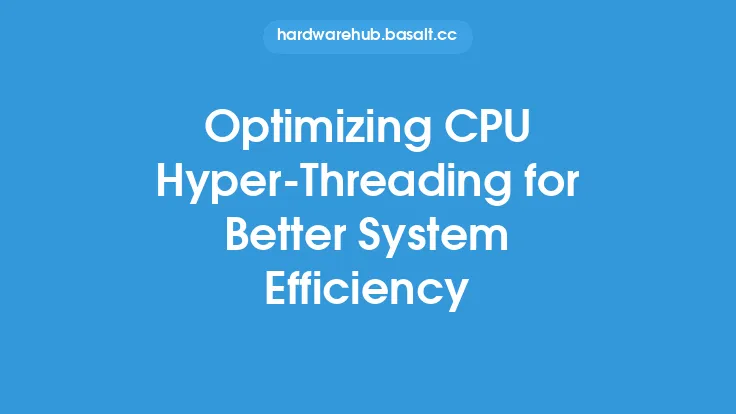As we delve into the world of computer processing, it's essential to understand the intricacies of CPU hyper-threading technology. This innovative feature has revolutionized the way processors handle multiple tasks, enabling them to execute multiple threads of execution concurrently. In this article, we'll explore the fundamentals of CPU hyper-threading, its architecture, and how it enhances system performance.
Introduction to Hyper-Threading Architecture
Hyper-threading, also known as simultaneous multithreading (SMT), is a technique used by Intel and other processor manufacturers to increase the throughput of their CPUs. The architecture of hyper-threading involves duplicating certain parts of the processor, such as the register files, while sharing others, like the execution units. This allows each physical core to handle multiple threads, effectively doubling the number of threads that can be executed simultaneously. The key components of hyper-threading architecture include the thread scheduler, which manages the allocation of threads to available execution resources, and the execution units, which perform the actual computations.
How Hyper-Threading Works
When a processor with hyper-threading is executing a thread, it can switch between threads quickly, allowing other threads to make progress while the first thread is waiting for resources, such as memory or I/O operations. This technique is known as context switching. The processor's thread scheduler is responsible for allocating threads to available execution resources, ensuring that each thread gets a fair share of the processor's resources. Hyper-threading also involves the use of a shared cache hierarchy, which allows threads to access shared data quickly, reducing the overhead of cache misses.
Types of Hyper-Threading
There are several types of hyper-threading, including symmetric multithreading (SMT) and asymmetric multithreading (ASMT). Symmetric multithreading is the most common type, where each physical core is divided into multiple logical cores, each with its own thread scheduler and execution units. Asymmetric multithreading, on the other hand, uses a combination of dedicated and shared execution resources to handle multiple threads. Another type of hyper-threading is dynamic multithreading, which dynamically allocates threads to available execution resources based on the workload.
Hyper-Threading in Modern Processors
Modern processors, such as Intel Core i7 and i9, and AMD Ryzen 9 and Threadripper, support hyper-threading. These processors have multiple physical cores, each with multiple threads, allowing them to handle a large number of threads concurrently. For example, the Intel Core i9-11900K has 10 physical cores, each with 2 threads, for a total of 20 threads. The AMD Ryzen 9 5900X has 16 physical cores, each with 2 threads, for a total of 32 threads. Hyper-threading is also used in server processors, such as Intel Xeon and AMD EPYC, to increase the throughput of server workloads.
Hyper-Threading and Power Consumption
One of the concerns with hyper-threading is its impact on power consumption. Since hyper-threading increases the number of threads that can be executed concurrently, it can lead to higher power consumption. However, modern processors have implemented various power-saving techniques, such as dynamic voltage and frequency scaling (DVFS), to reduce power consumption while maintaining performance. Additionally, hyper-threading can also lead to increased heat generation, which can affect the processor's reliability and lifespan.
Hyper-Threading and Operating System Support
To take full advantage of hyper-threading, the operating system must be designed to support it. Modern operating systems, such as Windows 10 and Linux, have built-in support for hyper-threading. The operating system can schedule threads to run on available logical cores, ensuring that each thread gets a fair share of the processor's resources. Additionally, the operating system can also provide tools and utilities to monitor and manage hyper-threading, such as thread scheduling and priority management.
Conclusion
In conclusion, CPU hyper-threading technology is a powerful feature that can significantly enhance system performance by allowing multiple threads to be executed concurrently. Understanding the fundamentals of hyper-threading architecture, how it works, and its types can help users and developers optimize their systems for better performance. While hyper-threading can increase power consumption, modern processors have implemented various power-saving techniques to mitigate this issue. As hyper-threading continues to evolve, we can expect to see even more innovative features and improvements in future processor designs.





